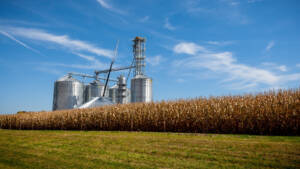
Trade

Issue Overview
America’s farmers and ranchers lead the world in producing safe, sustainable food, fiber and fuel for consumers at home and abroad. Agricultural trade is critical to our national economy and to the economic sustainability of family farms and ranches, but non-scientific trade barriers and tariffs restrict farmers’ ability to compete in global markets. We rely on robust trade agreements to establish a level playing field for farmers and ranchers and to protect the jobs and businesses that agriculture supports in the U.S.
Trade Initiatives
Agriculture and Tariffs
In 2018 the U.S. imposed Section 232 tariffs on steel and aluminum imports from major trading partners. The U.S. also imposed Section 301 tariffs on a range of imports from China. In response, China, the European Union, Mexico, and Canada imposed retaliatory tariffs on a wide range of agricultural products. These tariffs increased the price of U.S. agricultural exports in these markets which resulted in a reduction in exports. U.S. agricultural exports, due to the retaliatory tariffs, declined by $27 billion in 2018 and 2019, combined.
Many of the retaliatory tariffs on U.S. exports have been reduced or removed due to agreements. Canada and Mexico’s tariffs were removed in 2019, and China removed many tariffs on U.S. agricultural products with the U.S.-China Phase One Agreement in 2020. The European Union tariffs were suspended pending further agreements on steel and aluminum imports.
Tariffs on a variety of Chinese products, especially in the tech and energy sectors, are continuing in effect.
Indo-Pacific Economic Framework
The Indo-Pacific Economic Framework has been formally launched by the U.S., along with Australia, Brunei, India, Indonesia, Japan, Malaysia, New Zealand, the Philippines, Singapore, South Korea, Thailand, and Vietnam. The Administration’s objectives for the new IPEF includes working with the other countries to expand trade, improve supply chains, promote sustainability, support agriculture, and remove non-tariff trade barriers. The IPEF focuses on science-based food safety standards, will reduce trade barriers, and help expand trade opportunities for U.S. agricultural goods.
U.S. – Taiwan
The U.S. and Taiwan will begin trade talks following an agreed upon agenda, called the “Initiative on 21st-Century Trade.” Taiwan imported $3.8 billion of U.S. agricultural products in 2021, including beef, dairy products, soybeans, fruit, tree nuts, vegetables, and other products. An agreement that adopts science-based food safety standards will help expand trade opportunities for U.S. agricultural goods.
The agreed upon trade agenda will include science-based regulatory practices, agriculture collaboration on common standards, digital trade, labor, environment, trade facilitation, state-owned enterprises, and non-market practices. The initiative will not include market access measures such as reducing or eliminating tariffs.
U.S. – UK Talks
The United States and the United Kingdom began trade agreement negotiations in May 2020. The U.S. exported $2 billion in agricultural products to the UK in 2019, while the UK exported $1.9 billion in agricultural products to the U.S.
As the UK has left the EU it is able to conclude a trade agreement with the U.S. However, these negotiations have not continued since 2020.
Our trade negotiation objectives
- Include all agricultural products and policies in the negotiations
- Eliminate non-tariff trade barriers
- Ensure market access for biotechnology products
- Address issues concerning import-sensitive products
- Oppose the Precautionary Principle
- Oppose the use of geographic indicators
Recent Trade Agreements
U.S.-China Phase 1 Agreement
On Jan. 15, 2020, the U.S. signed a “Phase 1” trade agreement with China that went into force on February 14, 2020. As a part of the agreement, China has agreed to purchase at least $80 billion of U.S. agricultural products cumulatively in 2020 and 2021. The U.S. exported $27 billion of agricultural products to China in 2020 and $34 billion in 2021. Soybeans, corn, pork sorghum and wheat were major purchases by China.
Reforms in food standards affecting imports of beef, poultry, dairy, and horticultural products have been implemented by China. America’s farmers and ranchers are eager to get back to business globally and restoring our ability to be competitive in China is key to that.
Key Points
- Reduction or elimination of non-tariff barriers is included for meat, poultry, rice, dairy and other products. The biotechnology approval process is also improved.
- Tariffs, imposed on September 1, 2019, have been reduced from 15% to 7.5% on $112 billion of imports from China. Tariffs remain at 25% on $250 billion of imports.
U.S.-Mexico-Canada Agreement
With the implementation of the U.S.-Mexico-Canada Agreement, U.S. farmers and ranchers are eager to realize the more than $2 billion in additional farm exports and $65 billion in gross domestic product the pact is expected to provide. The three countries signed the USMCA, the successor to NAFTA, on Nov. 30, 2018, and a revised version of the agreement was signed Dec. 10, 2019. With all three countries having ratified the agreement, USMCA entered into force on July 1, 2020.
Key Points
- Ongoing work with Mexico to resolve disputes regarding biotechnology approvals and the use of glyphosate.
- Continued case with Canada’s dairy import regulations.
- Designed to replace the North American Free Trade Agreement, the USMCA builds on important trade relationships in North America.
- The agreement is expected to increase U.S. ag exports by $2 billion and result in a $65 billion increase in gross domestic product.
- The agreement will provide new market access for American dairy and poultry products while preserving the zero-tariff platform on all other ag products.
- In particular, the agreement gives U.S. dairy products access to an additional 3.6% of Canada’s dairy market – even better than what was proposed in the Trans-Pacific Partnership trade agreement.
- U.S. wheat will be treated more fairly, thanks to Canada’s agreement to grade our wheat no less favorably than its own.
- Mexico and the United States have also agreed that all grading standards for ag products will be non-discriminatory.
- Additional provisions enhance science-based trading standards among the three nations as the basis for sanitary and phytosanitary measures for ag products, as well as progress in the area of geographic indications.
- The agreement also includes measures that address cooperation, information sharing and other trade rules among the three nations related to agricultural biotechnology and gene editing.
Additional resources, including AFBF news and market analysis, can be found here.
WHAT WE'RE SAYING

Appeals Court Rules Against Reciprocal Tariffs
Sep 2, 2025
READ MORE

AFBF Welcomes Callahan Nomination to be Chief Ag Negotiator
Jul 17, 2025
READ MORE

USA Today: Negotiators Ended a Port Strike to Save Christmas. Can They Stop a Strike Again Next Week?
Jan 8, 2025
READ MORE

Over 20 Foreign Ag Attachés Visit Indiana Farm
Sep 30, 2024
READ MORE
TAGS
Top Issues
VIEW ALL